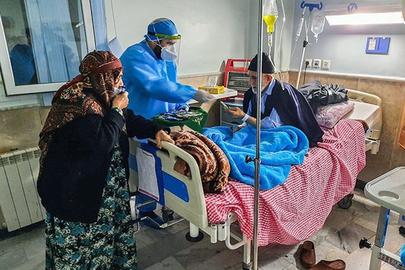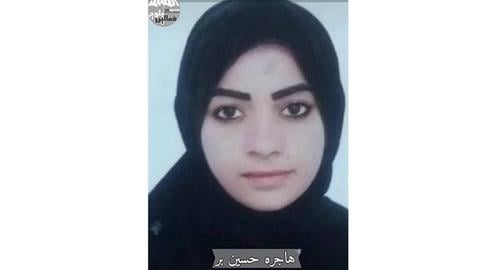Throughout the coronavirus outbreak, IranWire's Shahed Alavi has documented the trajectory of the crisis and how the government has handled it.
This is an update for IranWire's coronavirus chronology, covering the second week of May.
Read the full chronology to date.
Officials in several provinces expressed concern about the rise in coronavirus cases in the second week of May.
On May 11, Mohammad Reza Ghadir, president of Qom University of Medical Sciences, warned that in the previous 24 hours the number of patients with coronavirus symptoms who attended treatment centers had increased by 40 percent, and this could mean that Qom province might have to be put back on red alert.
Saeed Kashmiri, the president of Bushehr University of Medical Sciences, said the situation in the province was becoming more dangerous due to the high volume of traffic between Khuzestan and northern Bushehr, which was spreading the epidemic.
Khuzestan was on red alert and the number of coronavirus infections had increased by 300 percent, reported Gholamreza Shariati, the governor of Khuzestan. He said the fatality rate in the province stood at 5.3 percent, a very high figure compared to the international average, though he refused to divulge the exact number.
On May 14, academic staff at Chamran University in Ahvaz warned that Covid-19 was surging again in Khuzestan and blamed provincial officials for their lack of decisive action and because they allowed large crowds to gather in streets and in markets. In response to the surge, the Khuzestan governor had ordered the closure of banks, offices and non-essential businesses for six days in nine cities in the province including Ahvaz, Dezful, Shushtar and Majed Soleyman.
Khuzestan government spokesman Ali Rabiei agreed that crowds were to blame for the continued high numbers of cases, and singled out wedding and mourning ceremonies, in an apparent attempt to blame the public instead of the failure of the government to inform people, enforce strict guidelines and adequately provide treatment centers and hospitals with what they need in the crisis.
When asked to justify why Khuzestan was failing to release coronavirus statistics broken down city by city, Dr. Farhad Abolnejadian, the president of Ahvaz University of Medical Sciences, claimed that it would be “mentally upsetting” for individual cities if it presented data in such a way. As a result, he said, it had been decided that only total numbers for the entire province would be announced. He did, however, warn that the coronavirus epidemic in Khuzestan was at its peak.
Abolnejadian also reported that the names of coronavirus patients who had not been hospitalized had been given to local police stations because these people were required to quarantine themselves at home, but that many were not. The police would have to verify whether they were following the guidance or not.
Since infections and fatalities in Khuzestan province had increased, As’ad Sharhani, a member of Khuzestan Coronavirus Taskforce, said that it had opposed the re-opening of businesses and offices and had repeatedly asked for these re-openings to be delayed, but the National Coronavirus Taskforce in Tehran was very late in agreeing with their request and many places had opened in early May.
The hospitalization of coronavirus patients in Khuzestan province increased by 60 percent during the second week of May, according to Gholamreza Shariati, governor of Khuzestan. More alarming, he said, was that the number of walk-in patients who were infected with coronavirus has grown three-fold.
The governor attributed this increase partly to more testing being done and said there were now five test laboratories in the province. He said in a 24-hour period, the labs had carried out more than 1,275 tests and that they hope to increase it to 1,500 a day. Shariati warned that although the health facilities in the province had so far not been overwhelmed, they are still limited in their resources and that if people failed to observe the sanitary guidelines “we could suddenly face problems.”
On May 12, Lorestan province official Musa Khademi said the number of coronavirus infections in the province was increasing and the province was still on red alert. He reported that a state of emergency had been declared in the five cities of Khorramabad, Borujerd, Delfan, Dorud and Azna.
Just two days later, on May 14, Jafar Toulabi, the governor of the city of Khorramabad, the capital of Lorestan province, announced that, because of a jump in the number of coronavirus cases, the city was back under quarantine. He said that restrictions would remain in place until the city returns to a safer alert level. Gilan province was also reporting high numbers of cases.
Between May 12 and May 13, 120 people tested positive for coronavirus in Fars province and the number of known infections in the province had increased to 4,427, according to Abdolrasoul Hemmati, president of Shiraz University of Medical Sciences.
Dr. Alireza Zali, director of the Tehran Coronavirus Taskforce said that, in the same 24-hour period, the total number of hospitalizations for coronavirus in Tehran province had dropped by 8.5 percent and the curve of infections in Tehran was going down. However, he warned, Tehran is still in a fragile and unstable situation.
In early April, 71 percent of Tehran residents considered Covid-19 to be a very dangerous disease but, according to a survey conducted in early May, that number had fallen to only 46 percent, despite the fact that the epidemic was not in a significant enough decline. Zali described the attitude reflected in the survey as “worrisome.”
Ardebil province continued to be in a state of high alert, although the number of coronavirus cases had declined, warned Shahram Habibzadeh, president of Ardebil University of Medical Sciences. He encouraged people to pay more attention to sanitary guidelines, especially social distancing.
Hossein Farshidi, the president of Hormozgan University of Medical Sciences, described the increase in diagnosed coronavirus cases in the second week of May as “dangerous and worrisome.” He said that 10,023 people in the province had been tested for coronavirus and reported that 1,280 businesses were shut down for failing to follow sanitary protocols.
Mosques and Schools Re-open
In the second week of May, the reopening of mosques and other religious sites was a source of confusion; the matter had caused clashes between various government officials and religious leaders since the beginning of the quarantine period. Mohammad Qomi, the president of the Islamic Development Organization, said that all mosques in Iran would reopen on May 12, making sure to observe sanitary protocols. The Center for Managing Mosque Affairs, a body created by the order of Ayatollah Khamenei, said that it was not aware of any such plan. A few hours later, Mohammad Qomi amended his earlier statements and said that the mosques would reopen for three nights only for two hours each night to celebrate Laylat al-Qadr, the night that Muslims believe the first verses of Koran were revealed to Prophet Mohammad.
Mohammad Mohsen Baigi, the director general of the education ministry’s health department, said that students and teachers who suffer from health conditions that make them vulnerable to coronavirus are not allowed to attend school and emphasized that the students could only go if a face-to-face meeting was necessary. He added that students must wear masks and gloves.
The director of the Tehran Coronavirus Taskforce, Dr. Zali, also recommended that individuals over the age of 65 or under 18 and those who suffer from heart and lung ailments, diabetes, high blood pressure and asthma should not participate in May ceremonies to celebrate the revelation of the Koran to the Prophet Mohammad.
With the reopening of religious sites, schools and universities, Iran might witness another peak in the coronavirus epidemic, warned Davoud Yadegari, president of the Infectious Diseases and Tropical Medicine Research Center. He also warned, as others before him had, that in the coming winter, seasonal diseases such as influenza would make it more difficult for both patients and doctors to distinguish between coronavirus and influenza cases. Iran must come up with a comprehensive plan for vaccinating people against influenza, he said.
70 Doctors Contract Coronavirus Because of Shortage of Protective Gear
By May 12, at least 119 nurses, doctors and medical staff working in Iran’s health system had died because of coronavirus, said Maryam Hazrati, the health ministry’s deputy for nursing affairs. She added, however, that she was not aware of the exact numbers and that that announcement must come from another department at the health ministry.
As of May 13, in the city of Mashhad, around 70 doctors had been infected with coronavirus and two died in the city due to a shortage of protective gear in a private treatment center, announced Ali Birjandinejad, president of the Mashhad Medical Council. The council, he said, had pre-paid for the protective gear but was having trouble getting it. Earlier, officials from Mashhad University of Medical Sciences had claimed that no doctor in the city had died from coronavirus.
Tahereh Zahed-Sefat, the director of the Nursing School of Gilan University of Medical Sciences, reported that many nurses in the hard-hit province had been infected with coronavirus and there was a severe shortage of medical staff. Furthermore, Iran’s Nursing Council reported that, at the height of the coronavirus outbreak, the university hired 300 nurses, promising them full employment, but was currently only offering them only an 89-day contract without benefits. It was also reported that, at that time, nine nurses had died of Covid-19 in the province.
Testing Kit Claims and Concerns Over the Economy
Turkish diplomatic sources refuted a claim by Iran’s Foreign Minister Mohammad Javad Zarif that the country had sent 40,000 domestically-produced coronavirus test kits to Turkey. “We [have] sent 40,000 advanced Iran-made test kits to Germany, Turkey and others,” Zarif had tweeted on May 8. Germany had earlier denied receiving test kits from Iran.
Alireza Biglari, the director of Iran’s Pasteur Institute, claimed that serological antibody tests used to diagnosis coronavirus were of no use and that the best way of diagnosing this virus was via molecular tests (known as PCR or polymerase chain reaction). He explained that antibody tests only reveal past infections, not new ones.”
Oil minister Bijan Zangeneh announced that Iranian oil, gas and petrochemical industries had been hit hard by both the coronavirus epidemic and the fall in the international demand for their products, and some of the high-level projects in the sector had been suspended. He promised that those who had lost their jobs due to the situation would be given new opportunities.
According to a decision taken by the National Coronavirus Taskforce, announced Mahmoud Mahmoodzadeh, Deputy Minister of Roads and Urban Development, the courts will not issue eviction notices for tenants who have not paid rent so they will be able to remain in accommodation.
The welfare organizations of Isfahan, Alborz, Golestan, Ilam and North Khorasan officially announced that the rate of domestic violence had risen considerably since the coronavirus epidemic started. Emergency calls linked to domestic violence had increased anywhere from 10 to 50 percent. According to the parliament’s Research Center, more than six million jobs had been lost due to coronavirus and that the situation had led to domestic quarrels. These numbers, however, were denounced by some senior government officials and the media close to the Revolutionary Guards as attempts to “blackwash” the Islamic Republic.
Concerns over coronavirus spikes in prisons continued. Hamzeh Brujeni, director general of West Azerbaijan prisons, claimed that reports of unrest at Urmia Central Prison in protest against unsanitary conditions at the prison were untrue and, as of that moment, no cases of coronavirus had been observed at the province’s prisons — a claim that would have been very difficult to accept anywhere in the world.
visit the accountability section
In this section of Iran Wire, you can contact the officials and launch your campaign for various problems


























comments